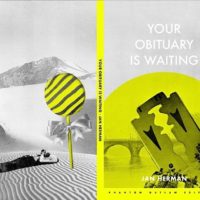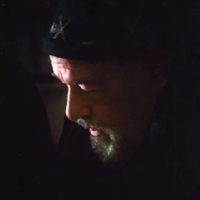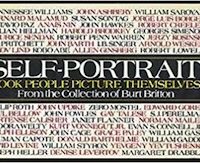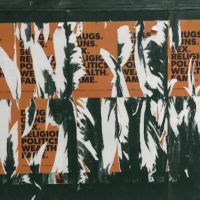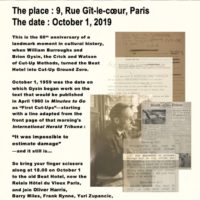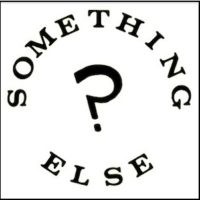The print edition of the New York Times this morning made note of the “Corrections We Remembered in 2019” (see the renamed, redesigned online version), pointing out that correcting a mistake is “more than a procedural obligation … it’s ‘an ethical responsibility.’” In that spirit I might as well point out that The Times can screw up badly when its highly trained and forward-looking designers push the envelope too far, particularly in the print edition of the magazine.
Fluxus Impresario Readied for His Closeup
A feature documentary about the impresario of the international avant-garde art movement Fluxus from 1962 to 1978. Interviews with artists include Yoko Ono, Jonas Mekas, and Nam June Paik. Dedicated to cooperative methods and expanded processes, Fluxus could be everything and almost anything: kits, shops, festivals, islands, weddings, food, or Flux Lofts—a network of artist-owned lofts in SoHo, New York. The iconoclastic George Maciunas and the spirit of Fluxus provoke questions still critical to many working artists . . . and a helluva lot of silly serious fun.
When You Get to Your 85th . . .
“So I sit there with earphones, mind you West End of forgotten City East of what used to be a shade of time. Let’s not get into that again… machine gun fire loud & clear… airplanes moving in low & forgotten now like battles in the Pacific… distant artillery for the Americans don’t forget that buddy… sound of Japanese commandos… & Germany end of July 45, 17 sec. past the deadline… sunny morning in Hiroshima, stones trees houses people dust… it’s the 15th with transcribed music… cracks in the record, the unconditional surrender of Hollywood to TV…” — Jürgen Ploog
Review: ‘Captivating … Teasing … Spare … Seductive’
“I was struck by poems made of lines that are poems all on their own—even as they unstack into melodic steps from top to bottom . . . Some are as spare as Chinese widsom. In Herman’s poems you know you are certainly ‘somewhere’ but maybe it’s somewhere only in atavistic memory, the realm of dreams. He writes with what Lavinia Greenlaw called ‘unsettled language,’ which brings less obvious aspects of imagination or observation to the fore . . . teasing, holding attention by where they might be heading. A doubtful adventure? A seductive noire? An obscene history lesson? And of course, mortality raises its knowing head more than once.” — Jay Jones
David Erdos in His One-Man Show About Lenny Bruce
At the Cockpit Theatre in London: ‘His Last Cabaret’
Plus his poem, ‘When a Tower Falls,’ which carries on Heathcote Williams’s legacy, but in Erdos’s own key: When a society falls, what you notice first is the rubble, / Seen on TV, ghosted buildings give way to dust / Through bomb blast. Through the sudden heat and the haze, / You will see only the print of lost towers, fading with age: / Time’s fragmented, and your first tasted moments / Clash and mix badly with the afterburn and the bitter / Of what could well be your last. Of course, the world has seen / Towers fall through man made event, false god sanctioned, / But we seem to have made no true effort to rebuild or renew / What was lost. What we lack has been leased and sold again / To new builders who continue to falsify all around us / While tapping us still for the cost. …
This Author Has a Beef With Amazon . . .
Richard Kostelanetz has produced many titles in his Archae Editions line of books over the past eight years via Amazon’s print-on-demand publishing service. But a few weeks ago they suddenly disappeared from the Amazon site. He was shocked. When he asked to have them restored, he was informed electronically that they had been removed because they contained pornographic images. He disagreed. Nevertheless, he decided to remove the “objectionable” content. Even as he offered to do so, however, he was further informed that his entire Archae Editions account had been closed—permanently. He would not be allowed to publish in the future any Archae books whatsoever. Period. Full stop. End of story. Fuck you.
A Traditional ‘Straight Up’ Thanksgiving
Our Thanksgiving team of the late William S. Burroughs and Norman O. Mustill has been a longtime happy pairing. It still is. So here they are again sweetened by Heathcote Williams’s words in a narration-cum-montage by Alan Cox. The total combo is delish.
The Week Begins
. . . . . . . . . . . . . . . with a stenciled text . . . . . . . . . . . . . . . . . . . . . . . . . . . . . . . . . . . . […]
Vostell’s ‘Lipstick Bomber’ Caught My Attention
MoMA’s redesigned galleries have put some great previously unseen pieces on display, like Wolf Vostell’s antiwar art. Lipstick tubes replace bombs in a “widely circulated war photograph” of a B-52 dropping its bomb load over Vietnam. I won’t argue with MoMA’s explanatory description that Vostell was “equating mindless consumerism with apathy toward contemporary injustices and violence.” Of course he was. But I would go much further than those abstractions. Seems to me he was equating it with mass murder and genocide. Coincidentally, a friend sent me a 50-year-old “telegram collage” about the Mi Lai massacre of March 1968, which he happened to see in some library archive. No abstractions here.
A Matter of Attribution & Legacy
“The art world has disfigured the legacy of the Puerto Rican Lower East Side artist Angel ‘LA2’ Ortiz by failing to acknowledge his contribution to Keith Haring’s work. Nobody has dealt with the racist issue of his exclusion from the Keith Haring legacy. Nobody of any consequence in the art world has the internal strength to deal with this ‘oversight.’ We all know what it is like to be cheated out of our rightful credit. But years’s worth of credit? Even though Ortiz’s art is clearly visible for all the world to see in Haring’s work? Ortiz has been cheated out of his credit in shows at prestigious museums, in books published by powerful institutions like the Whitney, and in credit left off Haring’s work at a world-famous auction house. Just totally ignored. Would that happen to a white artist?” — Clayton Patterson.
Wyler’s ‘Dodsworth’ at New York Film Festival
“This worldly, richly layered adaptation of Sinclair Lewis’s 1929 novel is one of the triumphs of the storied career of director William Wyler—and that’s saying a lot.” (New York Film Festival.) The chapter about the making of “Dodsworth”—and what went on behind the scenes—also was among the most pleasurable to write for my biography of Wyler.
Taking an ‘Opportunity’
Once upon a time Burt Britton asked me for a self-portrait. He subsequently included it in SELF-PORTRAIT: Book People Picture Themselves. I sent him as minimal an image as I could think of. More than three decades later he put all the originals up for auction. As I wrote at the time, many went unsold—Tomi Ungerer’s, Frank Gehry’s, Jorge Luis Borges’s. Which was ridiculous. More peculiar, mine found a buyer.
Drugs. Guns. Sex. Religion. Politics. Wealth. Fame.
It’s hard to believe that whoever pasted up these posters did not also rip them up. Hats off to the artist. Found dé-collage in midtown Manhattan. Photographed on the northwest corner of East 47th Street and Third Avenue.
It Was Impossible to Estimate the Damage . . .
The European Beat Studies network met in Paris to mark the 60th anniversary of the moment in cultural history when William Burroughs and Brion Gysin, the Crick and Watson of the “cut-up” method, turned the dingy Beat Hotel into their literary laboratory.
Fluxus, Intermedia and . . .
The Something Else Factor: Alison Knowles, Barbara Moore, Martha Wilson and I will be participating this evening in a panel about the glory days of Something Else Press, moderated by Hannah B. Higgins, at the Emily Harvey Foundation. It’s the first of four discussions organized by Christian Xatrec and Alice Centamore. The events are free. RSVP to ehf.nework@gmail.com
Jerry Pagane, Art Warrior
Born in 1948, underweight, no ears, and on Christmas Eve dumped on a church step. In the ’40s and ’50s people were afraid of the deaf. Imagine the mental isolation. The system had no way of dealing with a deaf orphan. He was placed in Pressley Rigeway for Disturbed Children and Home for Cripple Children, and seven foster homes.
N.O. Mustill: Master Collagist Before My (NY) Times
May we compare images? One appeared today, the other appeared in 1967. One is a great photoshopped illustration. Which is the work of art? Is there a difference besides technique? I’d say there is.




